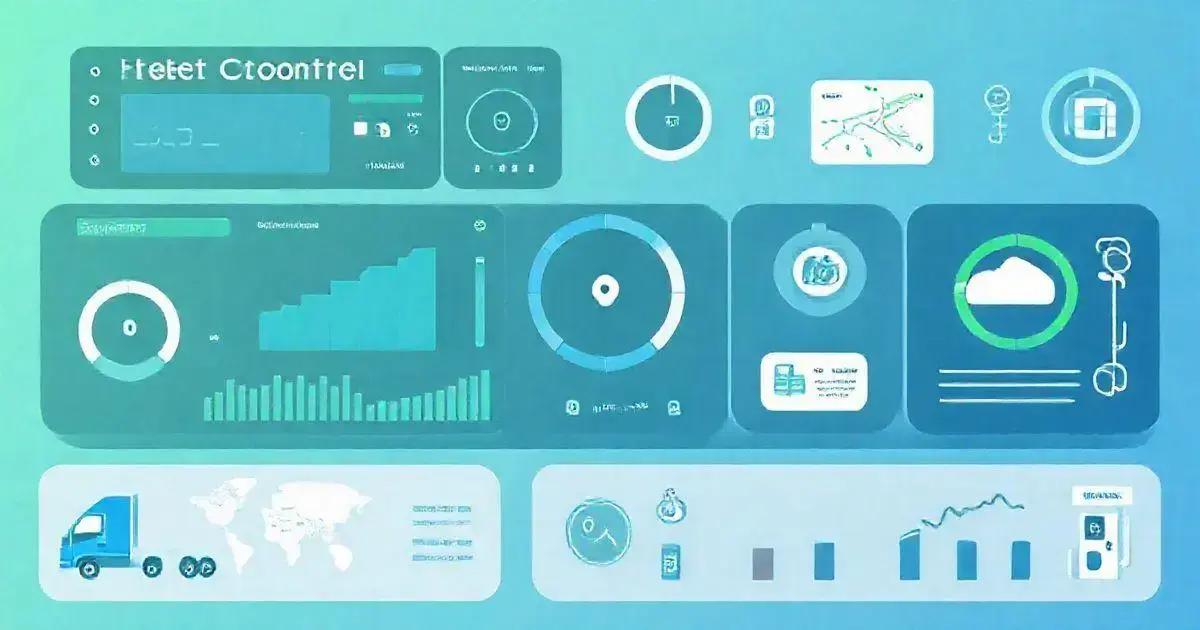5 Essential Features of Fleet Control Worksheet 7.0 Leave a comment
The Fleet Control Worksheet 7.0 is a vital tool for fleet management, offering features like travel control, tire management, and maintenance tracking to enhance operational efficiency. It includes Initial Dashboards for real-time metrics, Vehicle and Driver Registration for accurate record-keeping, Document Management for compliance, and detailed Travel and Tire Control to monitor expenses and protect investments. By utilizing this worksheet, fleet managers can achieve better resource allocation, cost savings, and improved safety in their operations.
The Fleet Control Worksheet 7.0 is revolutionizing how companies manage their fleet operations. In a world where efficiency is key, this spreadsheet does more than just track vehicles; it offers a comprehensive approach to optimizing performance and minimizing costs.
Designed for fleet managers, it includes features such as maintenance tracking, fuel management, and comprehensive dashboards to inform decision-making.
Initial Dashboards
The Initial Dashboards feature of the Fleet Control Worksheet 7.0 provides critical insights into your fleet operations at a glance. This dashboard is designed to help fleet managers easily visualize and analyze important metrics, enabling them to make informed decisions quickly. Here are some key components of the dashboard:
- KM by Driver: Track the total kilometers traveled by each driver, making it easier to evaluate performance and fuel efficiency.
- KM per Vehicle: Analyze the distance each vehicle has covered, which helps identify underutilized or overused vehicles in the fleet.
- KM per Liter: Measure fuel efficiency by calculating the kilometers covered per liter of fuel, empowering managers to optimize fuel use.
- KM per Trip: Assess the distance covered on individual trips, which can aid in route optimization and scheduling.
- Average Consumption per Vehicle: Understand the average fuel consumption for each vehicle to better manage maintenance and fuel efficiency strategies.
- Average Consumption per Driver: Compare drivers against one another based on their fuel usage and identify training opportunities to improve efficiency.
- Total General, Preventive and Corrective Maintenance: Keep track of all maintenance performed on each vehicle, ensuring timely service to prolong vehicle life and minimize repairs.
- Maintenance Cost Average: Analyze the average maintenance costs over time, helping to forecast future expenses and budget effectively.
- Total Cost of Mechanical and Electrical Maintenance: A detailed breakdown of costs associated with mechanical and electrical repairs, aiding financial decision-making.
- Total Tire Maintenance Cost: Track all tire-related expenses to manage procurement and replacements better.
- Total Lubricant Cost: Keep an account of lubricants used, which is essential for maintenance budgeting.
- Average Cost of Mechanical and Electrical Maintenance: Gain insights into the average costs incurred for mechanical and electrical issues to improve budgeting accuracy.
- Average Tire Maintenance Cost: Understand the average expenditure on tire maintenance and replacements to optimize spending in this area.
- Average Cost with Lubricants: Review overall lubrication costs to ensure efficient operations.
- Vehicles in Transit: Monitor active vehicles and their current locations to improve tracking and dispatching.
- Tires in Transit: Keep track of tire movement, especially useful for fleets that manage their own tire inventory.
- Delayed Vehicle Documents: Quickly identify vehicles with pending documentation issues, such as registration or insurance, to ensure compliance.
- Delayed Driver Documents: Similar to vehicle documents, this metric allows for tracking drivers who may have incomplete or outdated documentation.
- Delayed Preventive Maintenance: Ensure all preventive maintenance tasks are completed on time to avoid costly repairs later.
- Total Cost Versus Shipping: Compare operational costs with shipping income to evaluate the financial health of fleet operations.
- Fuel, Maintenance and Other Costs: A holistic view of all expenditures related to fleet management to identify areas for potential savings.
This dashboard not only aids in real-time decision-making but also helps set long-term goals for fleet optimization and cost management.

Vehicle and Driver Registration
The Vehicle and Driver Registration section of the Fleet Control Worksheet 7.0 is essential for maintaining accurate and organized records of your fleet. This feature simplifies the registration process and provides detailed tracking of both vehicles and drivers, ensuring compliance and efficiency in operations. Here’s what you can expect from this section:
- Driver Registration:
- Capture vital information for each driver, including name, contact details, license number, and expiration dates. This helps ensure that all drivers are properly licensed and certified.
- Monitor driver performance by linking each driver to their specific vehicles, making it easier to track performance metrics and mileage.
- Keep records of training and certifications, ensuring that all drivers meet the required safety and operational standards.
- Vehicle Type Registration:
- Document the type of each vehicle in your fleet, such as trucks, vans, or specialty vehicles, allowing for tailored maintenance and operational strategies.
- Track vehicle specifications, including make, model, year, and any modifications, to maintain accurate records for insurance and compliance purposes.
- Mechanical and Electrical Services Registry:
- Maintain a log of all mechanical and electrical services performed on each vehicle, helping to ensure timely maintenance and prevent future issues.
- Use this data to analyze patterns in repairs and services, which can help inform future vehicle purchases or replacements.
- Tree Service Registration:
- For fleets involved in tree services, register details pertaining to specific tasks and equipment used, enhancing operational efficiency and safety records.
- Track equipment maintenance schedules tied to tree service vehicles to ensure all machinery is in good working order.
- Lubricant Services Register:
- Document all lubricant services performed on vehicles, including types used and quantities, to help manage supplies and costs effectively.
- Ensure comprehensive tracking to facilitate budget planning for maintenance supplies.
- Register of Workshops and Suppliers:
- Maintain a list of preferred workshops and suppliers for vehicle maintenance and parts procurement, ensuring quick access to reliable services.
- Track costs associated with each workshop to identify trends in pricing and quality of services.
- Expenditure Type Register:
- Document different types of expenditures related to vehicles, such as fuel, maintenance, and repairs.
- Analyze spending patterns to identify areas for cost savings and budget adjustments.
- Refueling Station Registration:
- Record details of refueling stations used, including location, contact information, and pricing, to optimize fuel costs and logistics.
- Track fuel purchases by vehicle and driver to ensure accurate accounting and accountability.
- Fuel Type Register:
- Keep track of different fuel types used across the fleet, facilitating better management of fuel efficiency and costs.
- Analyze fuel consumption based on fuel type to optimize purchasing decisions.
This comprehensive registration system ensures that all vehicle and driver information is organized, accessible, and up-to-date, enhancing operational efficiency and compliance within your fleet management processes.
Document Management
The Document Management feature of the Fleet Control Worksheet 7.0 is crucial for maintaining organized records of all essential documentation related to vehicles and drivers. This section streamlines the process of managing documents, ensuring compliance and easy access when needed. Here’s what this feature entails:
Driver Document Control:
- Maintain a comprehensive record of all documents related to drivers, including licenses, certifications, and training records. This ensures that all drivers are qualified and compliant with regulations.
- Set reminders for document renewals, such as licenses and certifications, preventing lapses that could lead to legal issues or operational disruptions.
- Track any disciplinary records or training attended, helping to manage performance evaluations and promote continuous improvement among drivers.
Vehicle Document Control:
- Organize all documentation related to vehicles, including registration, insurance, and inspection certificates, ensuring that all vehicles are compliant and roadworthy.
- Monitor renewal dates for crucial documents like insurance and registration, reducing the risk of fines or penalties for non-compliance.
- Store maintenance records to track each vehicle’s service history, which is invaluable for resale evaluations or audits.
This effective Document Management system allows fleet managers to ensure that both drivers and vehicles are always compliant with necessary regulations and ready for operation. Proper documentation not only minimizes risk but also enhances transparency and accountability within the fleet management process.

Travel Control
The Travel Control feature of the Fleet Control Worksheet 7.0 is designed to streamline the management of trips and associated costs, ensuring your fleet operates efficiently and effectively. This section enables fleet managers to monitor all aspects of travel, from planning to execution, thus improving accountability and resource allocation. Here’s a detailed look at what you’ll find in this section:
Cargo Control Linked to Trips:
- Track cargo details for each trip, including weight, type, and destination. This helps ensure that all loads are compliant with regulations and optimally loaded.
- Maintain records of deliveries and pickups to ensure timely service and customer satisfaction.
Vehicle Control:
- Maintain a log of which vehicles are assigned to specific trips. This ensures optimal vehicle utilization and helps identify patterns in vehicle usage.
- Evaluate vehicle performance based on travel data, enabling managers to make informed decisions regarding maintenance and replacements.
Driver Control:
- Assign drivers to specific trips and track their hours of service, ensuring compliance with labor regulations regarding driving hours.
- Monitor driver performance during trips, assessing factors such as on-time arrivals and adherence to safety protocols.
Supply Control:
- Manage and track supplies and equipment needed for each trip, ensuring drivers have everything required for safe and effective travel.
- Monitor inventory levels and reorder supplies as needed to prevent shortages and delays.
Control of All Travel Expenses:
- Document and categorize all expenses associated with trips, such as fuel costs, tolls, and maintenance, to maintain a comprehensive overview of operational costs.
- Analyze travel costs against budgets to identify opportunities for savings and improve financial planning.
This Travel Control system not only enhances accountability but also improves overall operational efficiency by providing detailed insights into travel activities, allowing fleet managers to make data-driven decisions.
Tire Control
The Tire Control feature of the Fleet Control Worksheet 7.0 is an essential component for managing tire-related information effectively. Tires are a significant investment for any fleet, and proper management can lead to increased safety, efficiency, and cost savings. Here’s what is included in this section:
1. Identification for Each Tire:
- Maintain detailed records for each tire, including brand, model, size, and serial number. This helps ensure accurate tracking and easy identification during inspections or replacements.
- Link tire records to specific vehicles, allowing for efficient management and monitoring of tire usage across the fleet.
2. Tire Change Schedule by KM:
- Set and track a tire change schedule based on kilometers driven, ensuring that tires are replaced at appropriate intervals to maintain safety and performance.
- Receive alerts when tires are due for replacement based on usage data, preventing issues related to worn or damaged tires.
3. Signal of How Much KM is Left to Change the Tire:
- Utilize data to calculate and display the remaining kilometers until the next tire change is recommended, providing a clear view of tire health and longevity.
- Empower fleet managers to plan for tire replacements proactively, minimizing downtime and maintaining operational efficiency.
4. Status per Action:
- Track the status of each tire, indicating actions such as allocation to a vehicle, removal from a vehicle, scrapping, or undergoing maintenance.
- This ensures that every tire is accounted for and monitored throughout its lifecycle, facilitating efficient resource management.
This Tire Control feature is integral to maximizing the performance and safety of your fleet. By maintaining detailed records and implementing proactive measures, fleet managers can reduce costs associated with tire maintenance and ensure that vehicles operate smoothly on the road.

Maintenance Control
The Maintenance Control section of the Fleet Control Worksheet 7.0 is critical for ensuring that all vehicles in your fleet receive timely and effective maintenance. This feature helps fleet managers track and manage all aspects of vehicle maintenance, thereby enhancing vehicle reliability and safety. Here’s a comprehensive overview of what this section includes:
- Corrective and Preventive Maintenance Type:
- Document all corrective and preventive maintenance actions performed on each vehicle, ensuring that not only issues are addressed but also that routine maintenance is scheduled.
- This dual approach helps minimize unplanned downtime and extends the lifespan of fleet vehicles.
- Maintenance by Vehicle:
- Keep detailed records of maintenance activities specific to each vehicle, including dates, types of services performed, and associated costs.
- This information enables fleet managers to analyze patterns in maintenance needs and plan for future work effectively.
- Maintenance by Mechanical and Electrical Type, Tire and Lubricants:
- Track maintenance activities categorized by mechanical and electrical issues, as well as tire and lubricant services, to ensure a thorough approach to vehicle care.
- This segmentation allows for targeted maintenance strategies and helps in budgeting for future repairs or replacements.
- Maintenance Cost:
- Monitor and analyze the costs associated with maintenance activities to provide insights into budget management and spending efficiency.
- Understanding these costs can help in negotiating service contracts and identifying areas for cost reduction.
- Preventive Maintenance Schedule:
- Create and manage a preventive maintenance schedule that outlines when maintenance tasks should be performed based on mileage or time intervals.
- Regularly scheduled maintenance helps prevent breakdowns and costly repairs, promoting safer operation of vehicles.
- Preventive Maintenance Signal:
- Implement signals or reminders for upcoming preventive maintenance tasks, ensuring that nothing gets overlooked.
- This proactive alert system allows fleet managers to plan maintenance without disrupting operations.
- Status by: Scheduled, Accomplished and Delayed:
- Track the status of all maintenance tasks, categorizing them as scheduled, accomplished, or delayed. This visibility ensures accountability and helps prioritize maintenance efforts.
- Understanding the status of maintenance tasks can aid in resource allocation and strategic planning.
Overall, the Maintenance Control feature of the Fleet Control Worksheet 7.0 empowers fleet managers to implement a structured maintenance program, ultimately enhancing vehicle performance, safety, and longevity.
Conclusion
In summary, the Fleet Control Worksheet 7.0 is a powerful tool designed to streamline your fleet management processes.
With its comprehensive features covering everything from travel control and tire management to maintenance tracking, this worksheet offers fleet managers the ability to enhance operational efficiency, reduce costs, and improve vehicle safety.
By utilizing the initial dashboards, vehicle and driver registration, document management, travel control, tire control, and maintenance control, managers can make data-driven decisions that lead to better resource allocation and compliance with regulations.
The proactive approach encouraged by this worksheet ensures that your fleet remains reliable and effective.
Implementing the Fleet Control Worksheet 7.0 can facilitate a more organized and efficient fleet operation, ultimately contributing to the success and sustainability of your transportation efforts.
FAQ – Frequently Asked Questions about Fleet Control Worksheet 7.0
What is the purpose of the Fleet Control Worksheet 7.0?
The Fleet Control Worksheet 7.0 is designed to help fleet managers efficiently track and manage all aspects of fleet operations, including vehicle and driver registration, maintenance control, travel management, and tire tracking.
How does the Maintenance Control feature work?
The Maintenance Control feature allows users to document, schedule, and track all maintenance activities for each vehicle, helping to ensure timely repairs and preventative maintenance to enhance vehicle reliability.
Can I track expenses related to travel using this worksheet?
Yes, the Travel Control section enables you to document and categorize all travel expenses, including fuel costs, tolls, and maintenance, allowing for better financial management.
What kind of data can I monitor in the Initial Dashboards?
The Initial Dashboards provide insights into key metrics such as kilometers traveled by driver and vehicle, average fuel consumption, maintenance costs, and other performance indicators.
Is the Fleet Control Worksheet 7.0 customizable?
Yes, users can customize the worksheet to fit their specific fleet management needs, allowing for flexibility in tracking different types of data.
How can I ensure compliance with regulations using this worksheet?
The worksheet includes comprehensive features for document management, allowing you to keep track of necessary driver and vehicle documentation, ensuring compliance with legal and safety standards.

